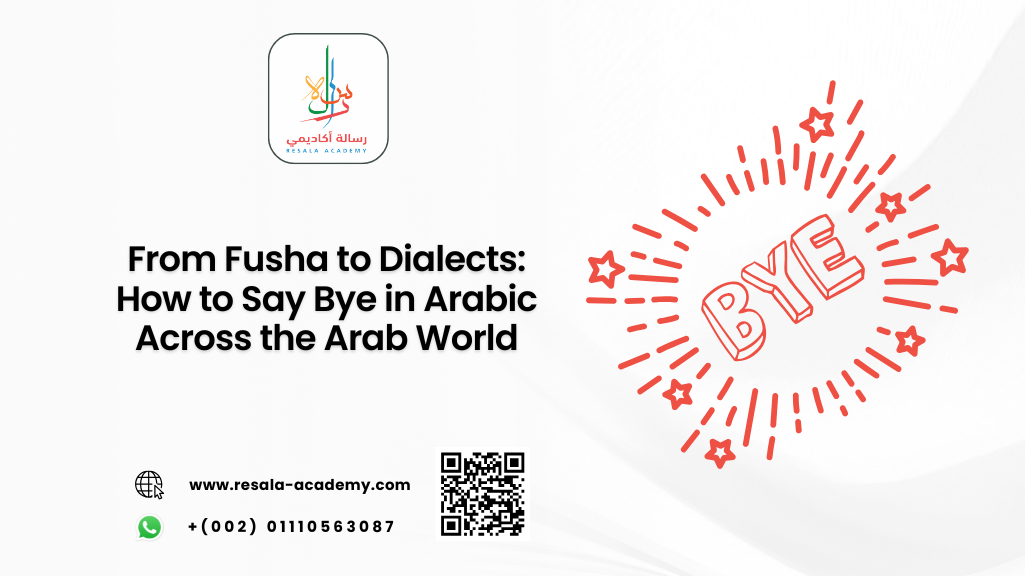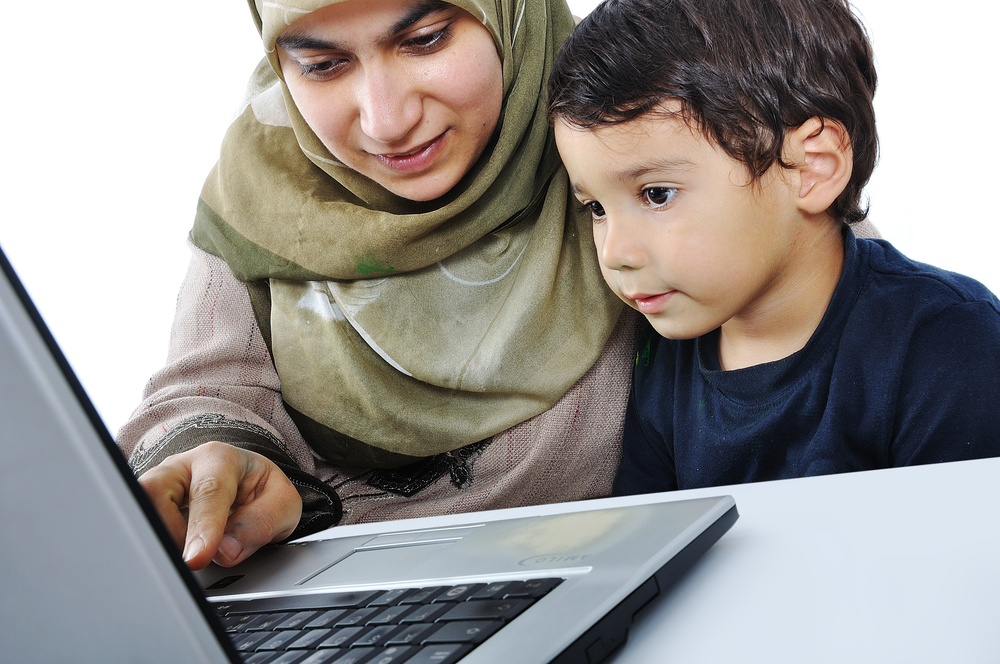Table of Contents
From Fusha to Dialects: How to Say Bye in Arabic Across the Arab World
Arabic is a language of profound beauty, rich history, and vibrant diversity. With over 400 million speakers across more than 25 countries, Arabic is not just one language—it’s a tapestry of dialects and expressions. One of the most fascinating aspects for non-native learners is how a simple word like “bye” can vary so widely across the Arab world.
In this article, we’ll explore how to say “bye in Arabic” in both Modern Standard Arabic (Fusha) and the most widely spoken dialects. Whether you’re a traveler, a language enthusiast, or a student of Arabic, this guide will help you navigate the cultural and linguistic nuances of saying goodbye.
And if you’re serious about mastering Arabic, we’ll show you how Resala Academy can help you achieve fluency with expert instruction and immersive learning.
Why Understanding Bye in Arabic Matters
Learning how to say goodbye in Arabic isn’t just about vocabulary—it’s about connection. Knowing the right farewell in the right context shows cultural respect, builds rapport, and enhances communication.
Since Arabic is a diglossic language, meaning it has both a formal written form (Fusha) and various spoken dialects, understanding these variations is key.
The Formal Way: Saying Bye in Modern Standard Arabic (Fusha)
Modern Standard Arabic (MSA), or Fusha (الفصحى), is the formal version of Arabic used in news broadcasts, official documents, literature, and education. It’s the foundation of the language and essential for any serious learner.
Common Ways to Say Bye in Arabic Fusha
- مع السلامة (Maʿa as-salāmah)
➤ Translation: “Go with peace”
➤ Usage: This is the most common formal way to say goodbye in Arabic. It’s appropriate in almost every situation. - وداعًا (Wadaʿan)
➤ Translation: “Farewell”
➤ Usage: More poetic and emotional, used in formal writing or when parting for a long time. - إلى اللقاء (Ilā al-liqāʾ)
➤ Translation: “Until we meet again”
➤ Usage: Slightly formal, often used in professional or polite conversations.
Dialectal Diversity: Saying Bye in Arabic Across the Arab World
Arabic dialects are as diverse as the regions they come from. Here’s how different countries and regions say “bye” in their local dialects.
Egyptian Arabic
Egyptian Arabic is one of the most widely understood dialects thanks to Egypt’s media.
- سلام (Salām)
➤ Translation: “Peace”
➤ Usage: Casual and friendly. Equivalent to “bye” or “peace out.” - مع السلامة (Maʿa as-salāmah)
➤ Still widely used in Egypt, especially among older speakers.
Levantine Arabic (Lebanon, Syria, Jordan, Palestine)
- بشوفك (Bashūfak / Bashūfik)
➤ Translation: “See you” (masculine/feminine)
➤ Usage: Friendly and informal. - الله معك (Allāh maʿak / maʿik)
➤ Translation: “God be with you”
➤ Usage: A heartfelt farewell, often used among close friends and family.
Gulf Arabic (Saudi Arabia, UAE, Kuwait, etc.)
- مع السلامة (Maʿa as-salāmah)
➤ Still the most common formal goodbye. - في أمان الله (Fī amān Allāh)
➤ Translation: “In God’s protection”
➤ Usage: Religious and respectful, used in both formal and informal settings.
Maghrebi Arabic (Morocco, Algeria, Tunisia)
- بسلامة (Bslāma)
➤ Translation: “With peace”
➤ Usage: Casual and commonly used in Morocco and Tunisia. - تهلا فراسك (Tḥalla frāsk)
➤ Translation: “Take care of yourself”
➤ Usage: Warm and affectionate, often said to loved ones.
Regional Expressions That Enrich the Meaning of Bye in Arabic
The diversity of the Arab world means that each region adds its own flavor to farewells. These expressions not only enrich your vocabulary but also help you connect more authentically with native speakers.
Sudanese Arabic
➤ Common phrase: سلام عليكم (Salām ʿalaykum) used both as a greeting and a goodbye
➤ Often followed by نشوفك قريب (Nshūfak qarīb) — “See you soon”
Yemeni Arabic
➤ Use: في أمان الله (Fī amān Allāh) with deep spiritual significance
➤ Often paired with درب السلامة (Darb as-salāmah) — “Path of peace”
Iraqi Arabic
➤ Phrase: مع السلامة حبيبي (Maʿa as-salāmah ḥabībī) — “Goodbye, my dear”
➤ Reflects the affectionate tone common in Iraqi culture
Libyan Arabic
➤ Use: يعيشك (Yaʿīshak) — a unique term meaning “May you live long,” often used as a farewell
➤ Can be paired with سلامتك (Salāmtak) — “Stay safe”
By integrating these culturally rich and region-specific variations of bye in Arabic into your learning, you not only enhance your fluency but also gain a deeper appreciation for the linguistic mosaic of the Arab world.
Cultural Nuances of Saying Goodbye in Arabic
In Arabic-speaking cultures, goodbyes are often elaborate and heartfelt. It’s not uncommon for farewells to include:
- Repeated phrases like “مع السلامة” and “الله معك”
- Physical gestures such as handshakes, hugs, or kisses on the cheek
- Religious blessings like “في أمان الله”
Understanding these customs enhances your cultural fluency and helps avoid awkward moments.
Contextual Goodbye Phrases: Beyond Just Bye in Arabic
Arabic is a language of context, and farewells often change depending on the situation, time of day, and relationship between speakers. For learners aiming to sound more native, mastering these contextual goodbyes adds depth to your communication skills.
When leaving a group or formal gathering
➤ Use: إلى اللقاء جميعًا (Ilā al-liqāʾ jamīʿan) — “Until we meet again, everyone.”
➤ This phrase is polite, inclusive, and ideal for academic or professional settings.
When parting late at night
➤ Use: تصبح على خير (Tiṣbaḥ ʿalā khayr) — “Good night”
➤ Often followed by وأنت من أهله (wa anta min ahlih) — “And may you be among its people,” a traditional response.
When someone is traveling
➤ Use: رحلة سعيدة (Riḥlah saʿīdah) — “Safe journey”
➤ Combine with في أمان الله (Fī amān Allāh) to convey both safety and spiritual protection.
When ending a phone call
➤ Use: أراك لاحقًا (Arāk lāḥiqan) — “See you later”
➤ This is a modern, casual way to say goodbye in Arabic, especially among younger speakers.
Master the basics of Arabic diacritics through fully-voweled words—an essential guide for beginners unlocking the secrets of correct pronunciation and reading. Read Now!
Learn Arabic the Right Way with Resala Academy
If you’re fascinated by the richness of Arabic and want to go beyond just knowing how to say bye in Arabic, it’s time to take your learning to the next level.
Why Choose Resala Academy?
Resala Academy is a premier online platform dedicated to teaching Arabic to non-native speakers. With expert instructors, interactive lessons, and a curriculum tailored to your needs, Resala Academy makes learning Arabic both effective and enjoyable.
Key Features:
- Native Arabic-speaking teachers
- Courses for all levels: Beginner to Advanced
- Flexible scheduling and 1-on-1 sessions
- Focus on both Fusha and dialects
- Cultural immersion and real-life conversation practice
Whether you’re learning for travel, work, or personal enrichment, Resala Academy offers the tools and support you need to succeed.
Your Gateway to Arabic Mastery: Enroll Today with Resala Academy!
Don’t just memorize phrases—understand them. At Resala Academy, you’ll learn how to say goodbye in Arabic and so much more.
Discover the beauty of Arabic grammar, the rhythm of its poetry, and the warmth of its people in our online Arabic course.
Ready to say “hello” to fluency and “bye” to language barriers? Click here to enroll now and start your Arabic journey today!
Frequently Asked Questions (FAQs)
1. What is the most common way to say “bye” in Arabic?
The most universally understood way is مع السلامة (Maʿa as-salāmah), which means “go with peace”. It is used in both formal and informal settings across the Arab world.
2. How do dialects affect the way “bye” is said?
Arabic dialects vary significantly. For example, in Morocco, people say بسلامة (Bslāma). Understanding dialects helps you communicate more naturally in different regions.
3. Can I learn both Fusha and dialects at Resala Academy?
Absolutely. Resala Academy offers courses in both Modern Standard Arabic and regional dialects. This dual approach ensures you’re equipped for both formal and everyday conversations.
4. How long does it take to become fluent in Arabic?
It depends on your goals and dedication. With consistent study and the structured guidance of Resala Academy.
Conclusion
Learning how to say bye in Arabic opens the door to a deeper understanding of the language’s richness and regional diversity. From the poetic elegance of وداعًا to the casual charm of مع السلامة, each expression carries cultural weight and emotional nuance.
Whether you’re exploring the dialects of the Levant, the Gulf, or North Africa, mastering these goodbyes is a step toward true linguistic and cultural fluency. And with the expert guidance of Resala Academy, that journey becomes not only possible but deeply rewarding.
So next time you part ways with an Arabic speaker, remember: it’s not just a “bye”—it’s a bridge to connection, culture, and communication.
Explore more Arabic expressions, cultural insights, and language tips by visiting Resala Academy’s Blog and take your first step toward fluency today!




